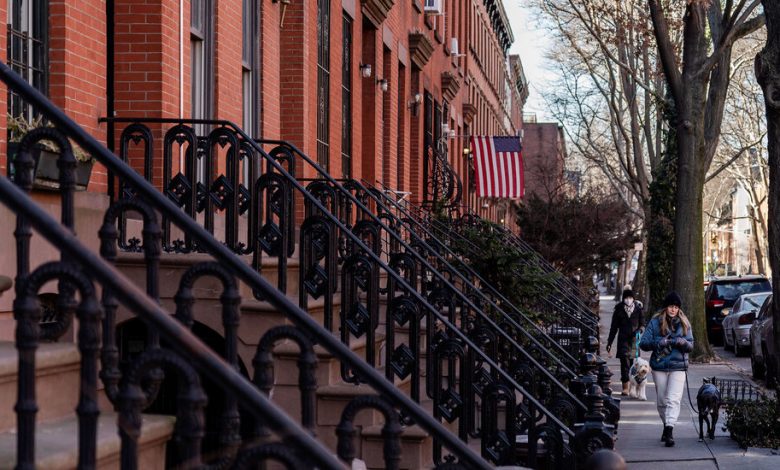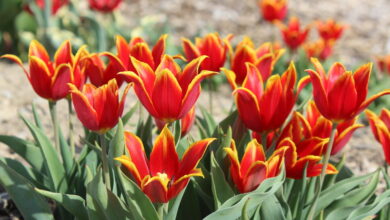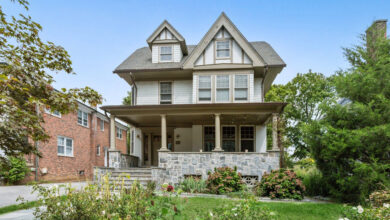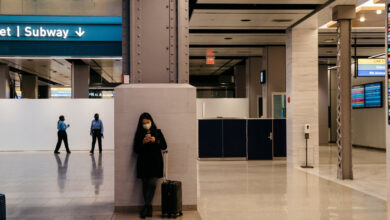Boerum Hill, Brooklyn: A ‘Village in the City’

Katie McShane and her husband, James O’Reilly, were apartment-hunting in Brooklyn in 2017 when they noticed a “for sale” sign in front of a brick townhouse in Boerum Hill. Ms. McShane, now 36, was intrigued. Mr. O’Reilly, 38, recalls thinking, “There’s no way we could afford a townhouse.”
Not on their own, anyway. So they teamed up with Ms. McShane’s brother and his wife to buy the four-story house for $3.3 million, converting it into two duplexes.
Life in Boerum Hill, with its 19th-century brick and brownstone rowhouses, has allowed the couple to “breathe a little deeper than in Manhattan, where we were previously,” said Mr. O’Reilly, the president of a co-working company. The “quaint” neighborhood is also minutes from amenities including Whole Foods and Trader Joe’s, he said. (Sure, there were more restaurants and bars on the Lower East Side, their old neighborhood, said Ms. McShane, a lawyer, but they made scant use of them.)
Residents praise the access to transportation, with 13 nearby subway lines — though only one station, the F/G at Bergen Street, is inside the neighborhood’s borders. “If you jump on the 2 or 3 train, it’s 10 to 15 minutes to Wall Street,” said Howard Kolins, who bought a circa 1899 brick building with a former college buddy in 1987 for $415,000.
Mr. Kolins, a live-events producer, is the president of the Boerum Hill Association, a civic group that has worked to preserve the low-rise character of the neighborhood. To that end, it was instrumental in the creation of the Boerum Hill Historic District, with nearly 250 buildings, in 1973, and the Historic District Extension, with an additional 288 buildings, in 2018.
“Boerum Hill is, as we like to say, ‘a village in the city,’” said Sue Wolfe, an agent with Corcoran and a onetime Boerum Hill resident. The neighborhood has long since transcended the time when “Realtors would have to say ‘Brooklyn Heights vicinity’” to attract buyers, Ms. Wolfe said.
Now, Mr. Kolins said, “We all say, ‘Gee, I couldn’t afford to live here if I was buying today.’”
What You’ll Find
According to a map of Brooklyn Community District 2, Boerum Hill is bounded by Schermerhorn Street to the north; Warren Street to the south (although some say Baltic Street); Court Street to the west; and Fourth and Flatbush Avenues to the east.
With its many Greek Revival and Italianate rowhouses, the neighborhood is part of what’s known as “brownstone Brooklyn.” Prospective buyers often think of it “almost like getting out of the city, because you have beautiful treed blocks, the buildings are very historic, you see lots of sky,” said Tamir Shemesh, an agent with Douglas Elliman. (Mr. Shemesh is currently selling condos at 561 Pacific Street, a 12-story building with a Japanese-inspired aesthetic.)
Thai, Japanese, Italian, French, Mexican, vegan and other cuisines abound at numerous neighborhood restaurants, many of them on Smith Street, a major thoroughfare where “you can shop, you can eat, you can get shoes, you can get your nails done,” Mr. Kolins said.
Cultural offerings include Roulette, a performance venue on Atlantic Avenue, another bustling business corridor, and the Invisible Dog Art Center, housed in an 1863 factory building on Bergen Street.
The area’s attractions led Ryan Serhant, a real estate agent familiar to viewers of Bravo’s “Million Dollar Listing New York,” to buy an 8,000-square-foot brownstone on Pacific Street in 2018 for $7.6 million.
“It’s location, location, location,” Mr. Serhant said. “I can walk home from a Nets game at the Barclays Center,” and the trip to his SoHo office “takes me 16 minutes by car.”
One neighborhood concern is the construction of 100 Flatbush Avenue, planned as the city’s first all-electric tower and the first of two towers in a project by Alloy Development. The developers have scaled back the size of the project, which will include affordable housing and two schools, and have been “very responsive,” Mr. Kolins said, but some residents remain concerned about a 44-story building facing low-rise homes on State Street.
What You’ll Pay
The median price of the 220 condominium and co-op units sold in 2021 was $1.275 million, a 6.3 percent increase over the median price of the 71 units sold in 2020, according to information provided by Ms. Wolfe and her daughter, Lissa M. Wolfe, also of Corcoran. The median price of the 36 townhouses sold during 2021 was $2,937,500, an increase of 2 percent over the median in 2020, when 19 townhouses sold.
As of Jan. 20, 61 homes in Boerum Hill were listed for sale on StreetEasy. The most expensive was a 10-room townhouse at 75 Bond Street, listed for $5.75 million. The least expensive was a 453-square-foot studio at 58 Saint Mark’s Place, listed for $595,000. (The highest priced condominium was an eight-room home with four bedrooms at 265 State Street, listed for $4.85 million.)
Of the 18 available rentals, the highest priced was a three-bedroom, three-bath apartment at 342 Bergen Street, asking $6,500 a month; the lowest was a four-room unit at 376 Atlantic Avenue, listed for $3,400 a month.
The Vibe
Both worldly and homey, Boerum Hill offers “a sense of urban life” while “somehow feeling like a small village,” Mr. Kolins said.
The neighborhood — whose borders touch other popular areas like Park Slope, Fort Greene, Gowanus and Downtown Brooklyn — is home to “a lot of Wall Streeters and attorneys,” along with “a lot of creative people,” he said. Bringing residents together are a yearly plant sale, a potluck holiday party and a biennial house tour. (In 2020, the house tour was canceled because of Covid-19, but “we’re thinking of doing it this year virtually,” Mr. Kolins said.)
The Hoyt Street Association maintains Hoyt Street Garden (one of three community gardens), where arts events and story hours are held. The garden is gated, but keys are given out “to neighbors and those who work nearby,” according to the association’s website.
Boerum Hill has been “more community oriented than we anticipated,” said Mr. O’Reilly, the erstwhile Manhattanite. “It’s nice to walk down the street, and you get a nod from your neighbors.”
The Schools
Elementary schools in Boerum Hill include P.S. 261 Philip Livingston, at 314 Pacific Street, and P.S. 038 The Pacific School, at 450 Pacific Street.
In 2020-21, P.S. 261 enrolled 691 students, from prekindergarten through fifth grade. In 2018-19, the most recent school year for which data was available, 58 percent met state standards in English, compared with 48 percent citywide; 53 percent met standards in math, compared with 50 percent citywide.
In 2020-21, P.S. 038 enrolled 547 students, from prekindergarten through fifth grade. In 2018-19, 63 percent met standards in English and 61 percent met standards in math.
M.S. 447 The Math and Science Exploratory School, at 345 Dean Street, enrolled 539 students from fifth through eighth grades in 2020-21. In 2018-19, 83 percent met state standards in English, compared with 47 percent citywide; 85 percent met state standards in math, compared with 41 percent citywide.
The Commute
While technically only the F and G stop inside Boerum Hill’s borders (at Bergen Street), other accessible lines include the A, C, B, D, N, Q, R, 2,3, 4, and 5 trains.
The History
According to the Boerum Hill Association, modern Boerum Hill began in the 1960s when a new resident, Helen Buckler, bought and renovated an old brownstone and sought a charming name to attract others to the area. She found it on a 1775 map depicting the 80-acre farm of Simon Boerum. Although there was no hill, the name Boerum Hill was born.
For weekly email updates on residential real estate news, sign up here. Follow us on Twitter: @nytrealestate.






